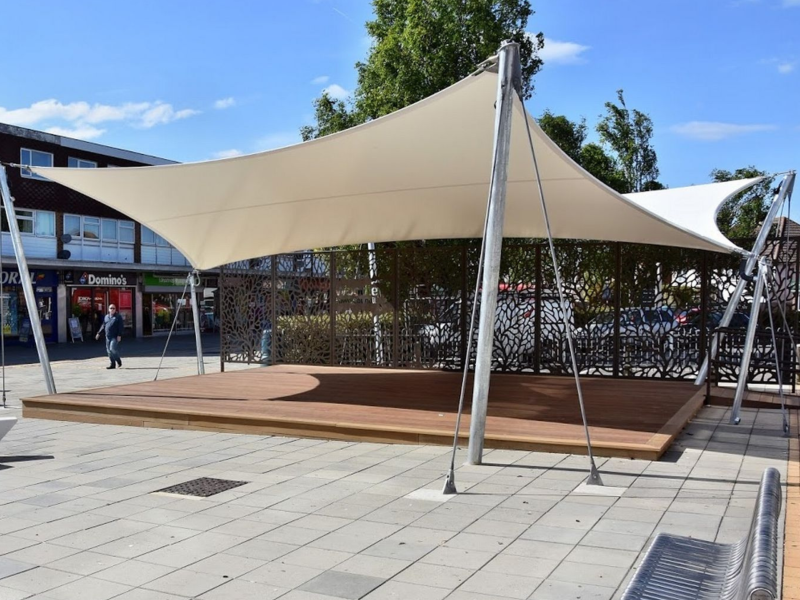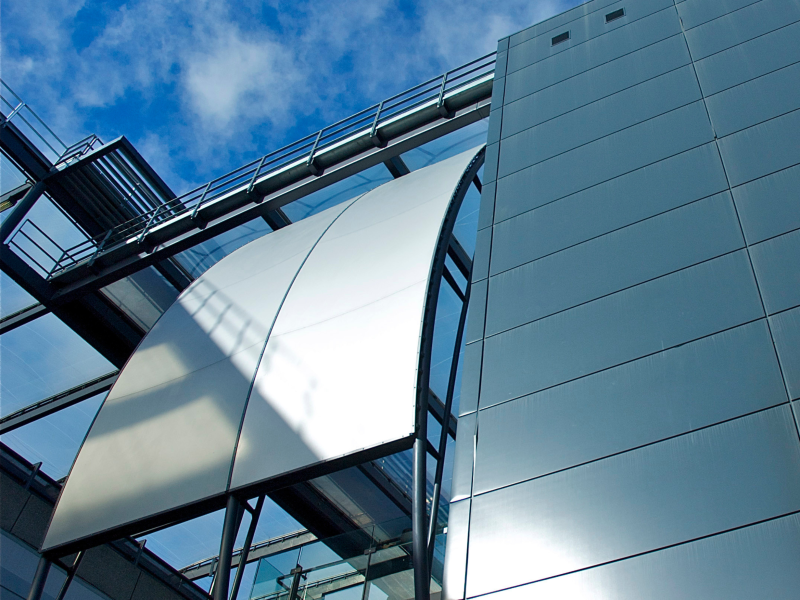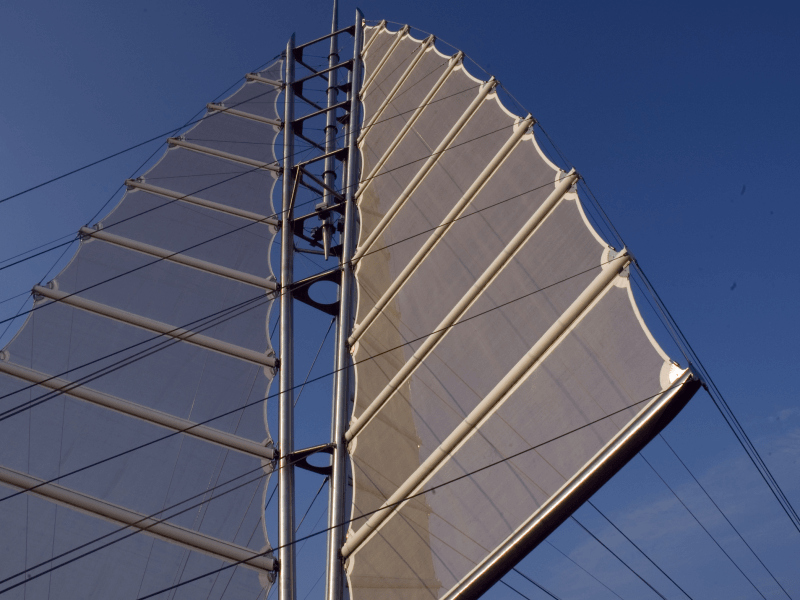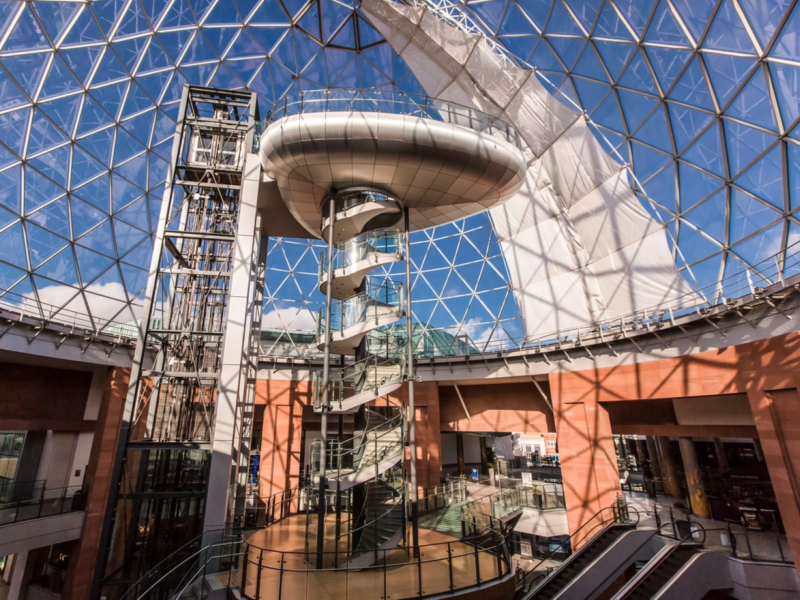Tensile Fabric Materials
Tensile fabric architecture is a captivating realm where engineering meets architecture, resulting in visually stunning and structurally innovative structures.
This architectural discipline relies on the use of various materials that possess unique properties to create lightweight, flexible, and translucent membranes that can span large distances and transform spaces.
PVC - Acrylic
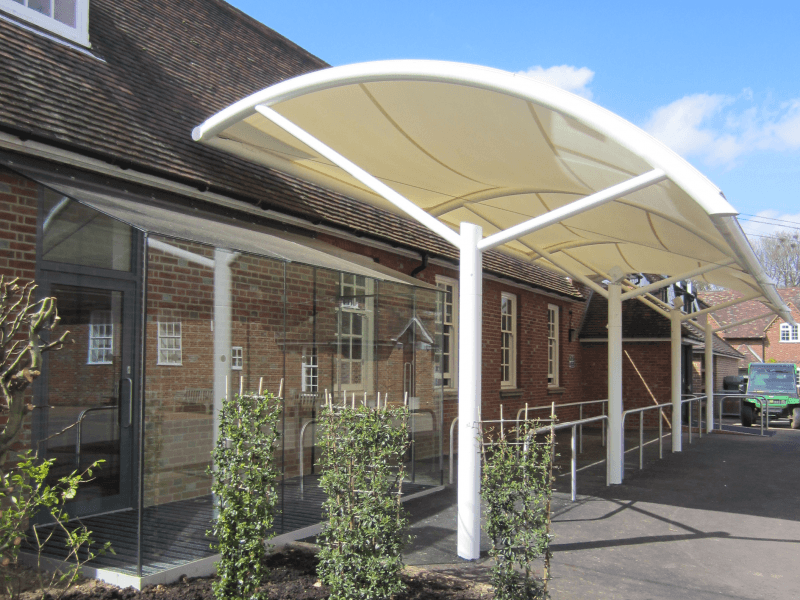
Acrylic Lacquered PVC (Polyvinyl Chloride), commonly known as PVC fabric, is a versatile and widely used material in fabric structures.
Combining the durability and strength of PVC with the wide choice of stock colours makes it an ideal choice for a range of applications. Mostly used for shade canopies, temporary event structures and industrial halls. This product has a typical design life of 15 years.
PVC - PVDF

PVDF (Polyvinylidene Fluoride) lacquered PVC fabric is a prominent material used in tensile fabric architecture, renowned for its exceptional durability, weather resistance, and aesthetic versatility.
This combination of PVC fabric as a base material with a PVDF coating results in a robust and long-lasting architectural membrane that can withstand the harshest environmental conditions. Typical design life is 20+ years.
Silicone Glass

Silicone coated Glass Fibre fabric is a unique and innovative material widely used in tensile fabric architecture and made by Valmeira Glass in the U.K.
This material combines the strength and durability of fibreglass with the exceptional heat resistance and transparency of silicone, resulting in a versatile fabric with a range of desirable properties.
PTFE Glass

PTFE (Polytetrafluoroethylene) glass, commonly referred to as PTFE-coated fibreglass fabric, is a highly advanced and widely used material in the field of tensile fabric architecture.
With exceptional strength, durability, translucency, and self-cleaning properties, thanks to it's Teflon surface, PTFE glass offers a myriad of benefits for creating iconic and long-lasting architectural structures. It is also non-combustible to B.S 476 Class O.
PVC Glass

PVC- glass, a combination of PVC (Polyvinyl Chloride) and woven glass fibre, is a versatile material used in the realm of interior tensile fabric architecture.
This unique hybrid brings together the advantages of both PVC and glass, resulting in a fabric that possesses exceptional qualities for architectural applications. Ideal for interior shading and livening up the interior of a building.
Working with J & J Carter
Selecting the right membrane material is a critical factor when designing and constructing tensile fabric structures. Various options such as PVC-acrylic, PVC-PVDF, silicone glass, PTFE glass, and PVC glass offer a wide array of characteristics and advantages, including durability, weather resistance, transparency, UV resistance, and fire retardancy. These materials provide architects and designers with the opportunity to create extraordinary structures that seamlessly blend functionality, aesthetics, and performance.
If you are considering incorporating a tensile fabric architecture or tension fabric structure into your project, J & J Carter is ready to assist you. With our expertise in designing and manufacturing tailor-made solutions that cater to your specific requirements, we can also provide efficient installation services. Contact us today to discuss your fabric architecture project and explore the possibilities.
Material Comparison List
A list of materials is a list of materials about the materials that J & J Carter use to build a structure out of material. The material can vary in material flexibility and material life span and material. There is A warranty on the material in case the material does not last or the material gets damaged. The material needs material maintenance but the material can be dirt resistant material and flames resistant material or straight up non combustable material material.
Demountable/ Relocatable Structures
Permanent Outdoor Structures also Internal Canopies
PTFE PolyTetraFluoroEthylene (Teflon)
PVDF - Polyvinylidene fluoride with TiO2 reinforcement
No further surface lacquer treatment required.
No further surface lacquer treatment required.
No further surface lacquer treatment required.
0% to 30%, White translucent typically 7%
0% to 30%, White translucent typically 7%
0% to 42%, White translucent typically 20%
0% to 17%, White translucnet typically 14%
White is standard, however special production runs of colours (RAL matched) can be done to a minimum order. Some PVC's depending upon the weight are available in limited colours.
White is standard, however special production runs of colours (RAL matched) can be done to a minimum order. Some PVC's depending upon the weight are available in limited colours.
White is standard. Colours available upon request subject to minimum order.
White (upon bleaching) is standard; however colour also possible.
Extensive range of colours in various weaves available from stock.
Dickson St Clair, Mehler, Verseidag
Mehler, Serge Ferrari, Verseidag
Valmiera Glass
Verseidag, FPC, Kastillo
Mermet
Ideal for relocatable structures and industrial / sports halls. A small selection of standard stock colours generally available.
Best suited to permanently installed structures, such as roofs, canopies, façades.
Perfect for permanent installations where a high light transmission is required, such as roof lights or atria.
PTFE has a proven track record for permanent structures and served well at airports and stadia.
Ideal for internal solar / glare control with a wide range of colours to choose from.

